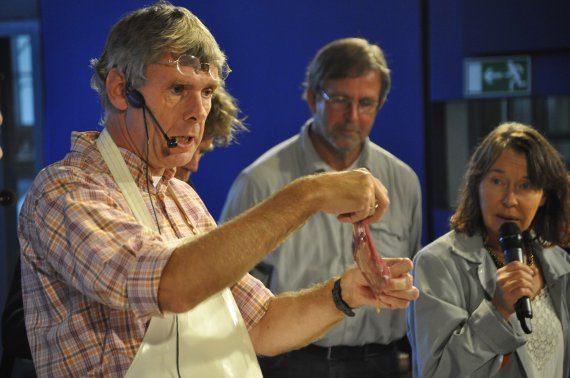Leopold turned pathologist-anatomist for a day last Friday in Leiden Museum’s LiveScience programme. In this educational series, visitors can get acquainted with work done by a researcher. This week’s programme will feature dissecting animals such as a hedgehog or a swift bird. But dissecting a shark is quite another story. Leopold and his colleagues dissected six sharks under the inquisitive eyes of hundreds of children. The sharks were caught in the Oosterschelde estuary. The aim of the operation was to investigate the sharks’ stomach contents.
Warming
Sharks in the Oosterschelde? ‘Yes,’ says Leopold. ‘This was also new to me when I was offered them. But it appears that fishers already know for some time that they are there. Catching the biggest ones have become a game to them. The current record stands at 163 centimetres.’ The sharks found here are not those in the Jaws movie, but the tope shark, a species which was fairly common in Dutch coastal waters until the mid 20 th century. ‘I fished out a report from the archives of the Royal Netherlands Institute for Sea Research (NIOZ) concerning the period 1930-1965. At that time, the NIOZ bought as many as 6000 of these sharks from fishers,’ relates Leopold, who has been reading up about the tope shark for this occasion. After 1965, the tope shark disappeared from Dutch coastal waters. Global warming might have played a role in the comings and goings of the shark, Leopold thinks. ‘The sea was also warmer in that period, like now.’
Eggs
That sharks get entangled in the nets of fishers can be attributed to them having been ‘fattened up’. Leopold says: ‘Towards the end of summer, the animals head towards shallow water to have their last big meals before moving on further.’ Their stomachs could be much fuller then. But what a disappointment! ‘Most of the stomachs were empty or almost empty. Why? That’s a mystery to me.’ All the sharks were females. Leopold: ‘This can be easily seen. Sharks are viviparous animals. They hatch their eggs in the oviduct. These animals were caught in September. They had already given birth to their young. But the oviducts are full of eggs for the next year; these are four to five centimetres big and each shark has 18 of them.’
Question
The audience, Leopold says, found all these very interesting and had the chance to ask as many questions as they like. ‘And the best question was: How long have you been working with sharks? Exactly one day!’

